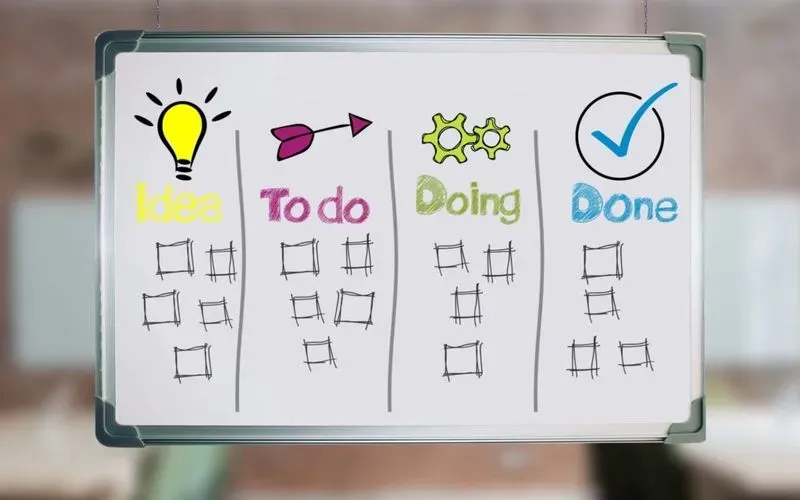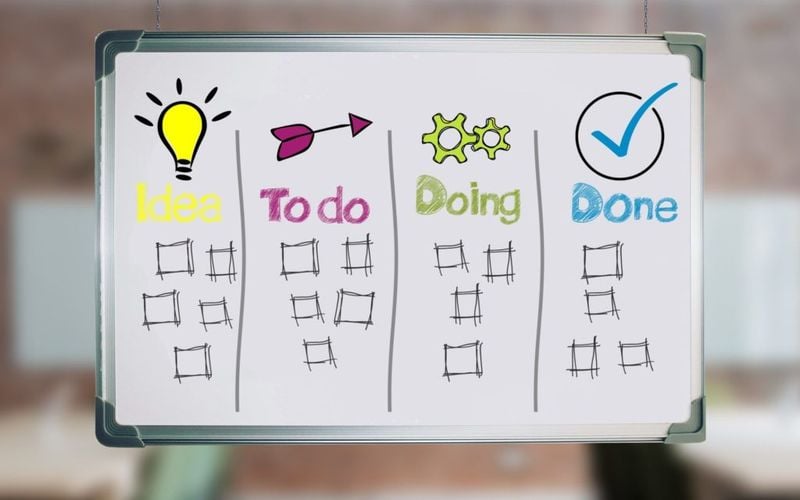The Kanban Method: Moving Beyond Sticky Notes
In this article, I’ll go over the Kanban method and how to effectively manage your agile projects.
Kanban is more than sticky notes on a wall. It’s an agile management method that lets project teams visualize their workflow to maximize efficiency. It is a concept that is hard to explain unless you know a little about its backstory.

Kanban grew out of Toyota’s lean management methods of the 1940s. Toyota’s plan was to minimize the waste and inefficiencies of traditional manufacturing. Toyota’s approach was to move to a “just-in-time” delivery method. Kanban was the scheduling component of the lean manufacturing model. The famous Kanban cards were used to focus employees on the work-in-progress (WIP) without losing track of the project timeline.
I rarely find Kanban fully implemented. Instead, I find Kanban combined with another management method, which is part of the Kanban’s appeal. You can overlay it on another method without significant disruption. Even so, I still find that the Kanban implementation falls short. Project managers are quick to adopt the Kanban cards and cycle times, but fail to manage the WIP or the workflow. They don’t really adhere to the Kanban philosophy when they adopt the methods.
To be honest, I think it may be the difference in perspective between the two cultures. Western culture isn’t as interested in the philosophy behind a method as it is in the method. In fact, many project managers probably feel a little uncomfortable talking about ‘implementing a philosophical approach to project management.” But it is the philosophical aspects of the method that makes it work. Perhaps, philosophy should be called theory. Maybe then project managers would go beyond the initial practices.
Kanban has six practices that are crucial to its implementation.
Visualize the Workflow
The original Kanban method recognized three parts to a workflow: Work to be done, Work being done, Work completed. Under each of these headings, specific work items were written on cards, with only one work item per card. The card was moved from one column to the next as the work moved through the workflow. I confess that I’ve used a similar method, long before Kanban became known. I may be a little biased.
I would create columns on a whiteboard that corresponded to steps in the project’s workflow. I would then use color-coded sticky notes or colored paper to write specific tasks under each column. I’d move the sticky notes around until I had a plan I thought would work. I would even have members of the project team look at the board as we worked through the project plan. It was much easier to see the possible bottlenecks and critical tasks when looking at the board.
I have even added horizontal swimlanes to the board to identify the key stakeholders in a project. I discovered that the more I put on a Kanban-like board, the more likely I was to lose focus. That is one of the secrets of the Kanban method — taking a minimalist approach to workflow.
Limit the Work in Progress
Most project managers are trained to plan for the maximum rather than the minimum. That mentality often forces individuals to stop mid-stream to help with another task that is falling behind. The bouncing back and forth on project tasks contributes to inefficiencies and often leads to late deliverables. With Kanban, the focus is on limiting the work-in-progress to what the resources can support. If WIP has no constraints, then it isn’t following Kanban. A task from the To Be Done column cannot move to the WIP column unless capacity exists to complete the task. If you follow the constraints, you will quickly see where the problems are in your workflow.
Keeping the WIP within constraints is one of the hardest transitions from traditional planning methods. It is hard to break old habits, but the simplicity of the WIP makes it easier for all team members to stay focused. Sometimes, I remove the backlog column from a daily view if team members become so focused on the outstanding work that they lose focus on the WIP.
Managing the Workflow
The goal of a Kanban-managed project is a smooth workflow that delivers value to the customer in the shortest cycle time. That means the focus shifts from the people to the work. I don’t need to continually manage the people. Instead, I manage the work. I make sure that the backlog is properly prioritized and that the feedback loop is functioning. I set up the workflow so there’s no lag between the completion of one work item and the start of the next backlog item.
The three practices of visualization, limitation, and management of workflows are the technical details of the Kanban method and the one most often used. But there are three additional practices that address the human component of any project. These practices are less likely to be implemented, although, without them, the process doesn’t work.
Explaining the Process
Before trying to put the Kanban method into practice, get buy-in. If you can’t get the team members to see the value of the Kanban approach, you will have difficulty getting anyone to participate. One of the best ways I know is to create a Kanban board for a project and have team members stand in front of the physical board to discuss the project. As people become familiar with how the workflow works, they can visualize how the method works. It is this picture that creates the necessary buy-in. At that point, it is important to document the process in terms of the number of WIP tasks, the feedback loop requirements, and the backlog prioritizing. Be sure everyone reads the document and allow for feedback so the process can be refined.
Creating Feedback Loops
Daily meetings should be held in front of the Kanban board — whether the board is physical or virtual. The daily meetings should be no more than 10 to 15 minutes and should be held standing up. These quick update meetings help team members know where the overall project stands and enables team members to ask and answer questions. You may not think that 15-minute meetings have any value, but I’ve found them to be one of the best ways to facilitate information transfer. Just make sure that these 15-minute status meetings are explained in the process document and hold team members to the rules. If needed, set a timer when each person starts speaking to keep the meeting moving forward.
Enabling Collaboration
As a project manager, it is your responsibility to create a collaborative environment where team members feel free to discuss process improvements and innovation. The concept of limiting WIP requires team members to work together to get tasks done. Participating in the process creates a collaborative environment that can be used as the basis for ongoing discussions on improvement and innovation. I’ve learned that the best way to enable collaboration is to start in front of the board and talk through the project. If team members feel comfortable sharing from the start, the collaborative environment grows as the project moves forward.
The Kanban philosophy is simple. Its implementation is not. The goal of Kanban is to simplify the work process so people can manage themselves in a collaborative environment that leads to innovation. It’s what every company wants.





